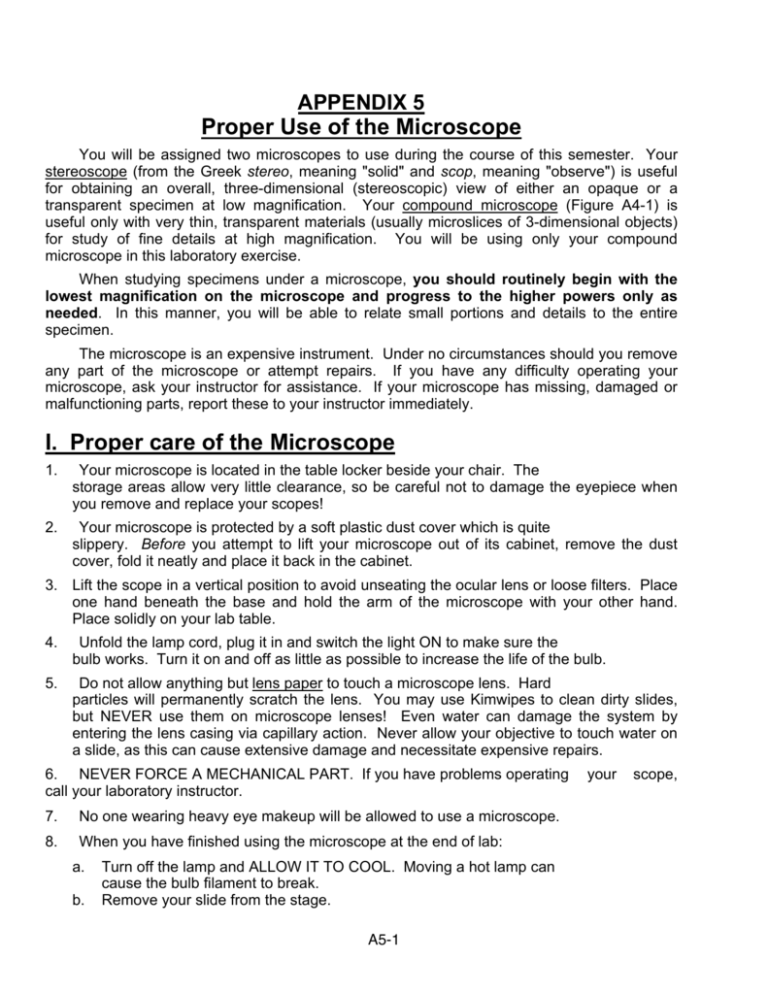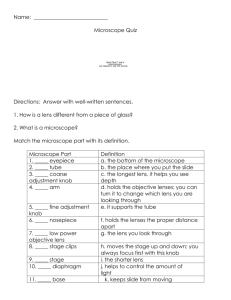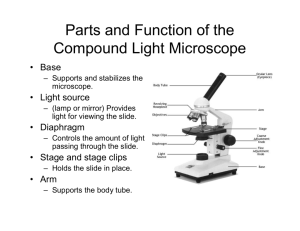Microscope Use: Proper Care & Function - Lab Guide
advertisement

APPENDIX 5 Proper Use of the Microscope You will be assigned two microscopes to use during the course of this semester. Your stereoscope (from the Greek stereo, meaning "solid" and scop, meaning "observe") is useful for obtaining an overall, three-dimensional (stereoscopic) view of either an opaque or a transparent specimen at low magnification. Your compound microscope (Figure A4-1) is useful only with very thin, transparent materials (usually microslices of 3-dimensional objects) for study of fine details at high magnification. You will be using only your compound microscope in this laboratory exercise. When studying specimens under a microscope, you should routinely begin with the lowest magnification on the microscope and progress to the higher powers only as needed. In this manner, you will be able to relate small portions and details to the entire specimen. The microscope is an expensive instrument. Under no circumstances should you remove any part of the microscope or attempt repairs. If you have any difficulty operating your microscope, ask your instructor for assistance. If your microscope has missing, damaged or malfunctioning parts, report these to your instructor immediately. I. Proper care of the Microscope 1. Your microscope is located in the table locker beside your chair. The storage areas allow very little clearance, so be careful not to damage the eyepiece when you remove and replace your scopes! 2. Your microscope is protected by a soft plastic dust cover which is quite slippery. Before you attempt to lift your microscope out of its cabinet, remove the dust cover, fold it neatly and place it back in the cabinet. 3. Lift the scope in a vertical position to avoid unseating the ocular lens or loose filters. Place one hand beneath the base and hold the arm of the microscope with your other hand. Place solidly on your lab table. 4. Unfold the lamp cord, plug it in and switch the light ON to make sure the bulb works. Turn it on and off as little as possible to increase the life of the bulb. 5. Do not allow anything but lens paper to touch a microscope lens. Hard particles will permanently scratch the lens. You may use Kimwipes to clean dirty slides, but NEVER use them on microscope lenses! Even water can damage the system by entering the lens casing via capillary action. Never allow your objective to touch water on a slide, as this can cause extensive damage and necessitate expensive repairs. 6. NEVER FORCE A MECHANICAL PART. If you have problems operating call your laboratory instructor. 7. No one wearing heavy eye makeup will be allowed to use a microscope. 8. When you have finished using the microscope at the end of lab: a. b. Turn off the lamp and ALLOW IT TO COOL. Moving a hot lamp can cause the bulb filament to break. Remove your slide from the stage. A5-1 your scope, c. Rotate the nose piece until the low power objective is over the condenser. d. Wipe any liquid or dirt off the stage or body. If a lens is dirty, carefully clean it with lens paper. e. Unplug the cord and fold it neatly, following its natural "zig-zag." Tuck it under the microscope stage, between the arm and light source. DO NOT WRAP THE CORD AROUND THE BASE, AS THIS CAUSES WIRE FATIGUE. f. Carefully place the scope in its cabinet (Use both hands!), and replace the dust cover. Pull the dust cover all the way over the base. g. Lock the cabinet with the combination padlock, keyhole facing outwards. II. Parts of the Compound Microscope 1. The base is the support upon which the instrument rests. 2. The stage is the rectangular platform upon which the microscope slide is placed. A hole in the center of the stage allows light to pass from the light source beneath the stage through the slide specimen, which should be centered over the hole in the stage. Keep the stage dry at all times. Fluids can damage metal parts and also make it difficult to move a slide around on the stage. 3. The light source is housed in the base of the microscope. A switch located on the right hand side of the base allows you to vary the intensity of the light source. Always turn the light off when you are not using the microscope. 4. 5. 6. Directly beneath the stage is the condenser, which concentrates the light beam The iris diaphragm is attached below the condenser. A small lever allows you to control the diameter of the iris opening through which the light passes. When the diameter is decreased to allow only a very narrow cone of light to pass through the specimen, the resolution (sharpness) and depth of field of the image is increased. The body tube supports the two lens systems (hence the term “compound” microscope) comprising the optical or magnifying system. a) At the top of the body tube are the oculars, or eyepieces, the lenses through which you look. Your ocular magnifies the image l0 times and is called a l0X ocular. Note that your scope is binocular: it has one ocular for each of your eyes. b) To the bottom of the body tube is attached a revolving nosepiece which can be rotated to bring the various objective lenses into position. (A "click" indicates when the objective is in position.) The shortest (low power) objective magnifies 4X, the intermediate objective magnifies 10X and the longest objective (high power) magnifies 40X. When switching lenses, turn the nosepiece ring while holding its edges. DO NOT use the lenses as handles to swivel the ring, as this will gradually unscrew the lens and make focusing impossible! A5-2 Figure A4-1. The Alphaphot 2 Nikon Student Microscope. A5-3 7. The focusing adjustment knobs are located on either side of the microscope. The larger pair is the coarse adjustment and the smaller pair is the fine adjustment. Coarse adjustment should be used only to obtain approximate focus, as it moves the stage a considerable distance with relatively little knob movement. Fine adjustment is used to obtain an exact and clear focus after an approximate image has been obtained with the coarse adjustment. IMPORTANT: Never use coarse focus except with the low power objective lens! It is very easy to drive an objective through a slide. This destroys the slide and can scratch the lens! The ratchet mechanism for moving the stage is thrown out of alignment when only one knob is turned during focusing. This results in costly repairs. Always use both hands when moving focusing knobs. 8. When properly adjusted, your microscope should be parfocal, meaning that your image should remain in fairly good focus even when you switch from a lower to a higher power lens. To adjust your scope to the parfocal setting (zero diopters), turn the ribbed collar of the adjustable ocular until the two white dots on the collar and lens barrel line up. After you have done so, use the coarse and fine adjustment knobs to focus the image. III. Functions of the Compound Microscope 1. Magnification One function of the microscope is the magnification, or increase in apparent size, of the image of very small objects. Recall that you are working with a two-lens system in which the real image formed by the objective lens is further magnified by the oculars. Therefore, the image that finally reaches your eye has a total magnification which is the product of the magnifications of the two lenses being used. With the l0X objective in use, the total magnification of the observed image is equal to the objective magnification (10X) times the ocular magnification (10X), or 100x. What total magnifications are possible with your compound microscope? Low power:________ medium power:________ high power:_______ 2. Resolution A microscope which simply magnifies tiny objects barely visible to the unaided eye would be of little use. The second function of the microscope is to increase the resolution (i.e. - the illumination of detail) of very small objects. On the front bulletin board is a laminated figure labeled "Comparison of the image obtained from the light and electron microscopes" (From Cell Ultrastructure by Jensen and Park). Both images are magnified to approximately the same degree. What can you conclude about the resolution of detail shown by each type of microscope? Resolution is a measure of the capacity to distinguish two points as separate objects. You may be familiar with this phenomenon in terms of photography. Low resolution photographs, such as those printed in a newspaper, are rather grainy. One can see the individual shaded "dots" (pixels) used to create the image. Higher-resolution films, such as A5-4 those used in color magazines, have higher resolution--more pixels per unit area--which creates a crisper, more resolved image. The visible light we use to illuminate microscope slides is made up of indivisible energy "packets" called photons, which have characteristics of both energy and matter, and like all forms of energy, travel in waves. Visible light, along with other forms of energy, form a continuum known as the electromagnetic spectrum. The em spectrum is arranged by wavelength (the distance between the crest of one wave and the next). Units of measurement commonly used to express wavelength are the millimeter (mm), micrometer (mm), nanometer (nm), and Angstrom (Å). An optical system is limited in resolving power by the wavelengths of energy being used to illuminate the specimen. The lower limit of resolving power for any image-forming system is directly related to the wavelength of the energy being used to form the image: the shorter the wavelength, the greater the resolving power. The resolution of an optical system (e.g., your eye or your microscope) can be calculated with the formula R = 0.61λ N. A. In which R = the smallest distance between two points that can be distinguished as separate by the optical system. λ = the wavelength of light used for viewing (in units of length, such as nanometers (nm)). N. A. = the numerical aperture of the objective lens, a dimensionless (i.e. having no units of measurement) ratio 0.61 = a dimensionless constant. The numerical aperture of each of your objective lenses is etched on the lens barrel, along with its magnification. Using the above formula, calculate the limits of resolution for each of your objective lenses. Because you will be using white light (a combination of all wavelengths) to view your specimens, you may designate l as 610 nm, approximately the average wavelength of white light. Note that the units of l will also be the units of R. Low power: _____________________ Medium power:__________________ High power: ____________________ Use your microscope with care, treat it with respect, and it will serve you well. A5-5





